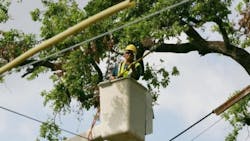It’s that time of year when it’s natural to reflect on the past. Hopefully, in doing so, we can find some optimism for the future. Back in April I criticized politicians and regulators for their quaking resolve in reducing future electric system storm damage. Having done so, I also need to give credit where credit is due.
I recently came across an article by Kate S. Alexander, a staff writer for Gazette.Net, Maryland Community News. Here is some background that the article provides. The Maryland Electric Service Quality and Reliability Act was passed in 2011 after regulators learned PEPCO was one least reliable utilities. That Act led the regulators to enact RM 43, which sets electric reliability standards, metrics to hold the utilities accountable and specific conditions for the trimming and removal of trees.
RM 43 requires utilities to prune trees so as to provide at least four years of clearance. However, if obtaining that clearance would result in removing 25% or more of the tree’s crown, then the tree is to be removed. Anyone with a grasp of arboriculture knows that such a requirement for the removal of trees did not arise arbitrarily but coincides with ANSI A300 pruning standards. For those not familiar with pruning standards, the reason for that is that removing 25% or more of a tree in one pruning event results in a very high risk for tree mortality. Obviously, if what the utility is doing results in standing tree carcasses, this increases the risk not only to electric facilities but also to private property and the public.
The events that triggered Alexander’s article were that Senator Brian J. Feldman and Montgomery County Councilman Roger Berliner took up the cause of residents who had unsuccessfully sued to stop the PEPCO from acting on the terms of a 1959 easement. These politicians asked PSC Chairman Kevin Hughes to stop the utility’s activity which they viewed as “so very aggressive”.
Property owners believe PEPCO could trim rather than remove many of the trees on their properties.
Roger Berliner wonders whether it’s possible to find “that sweet spot” for electric reliability, where trees don’t interfere with power lines and trees are not needlessly trimmed or removed. It’s not a bad question Councilman but in asking it, are you not implying that the PSC and the utilities are not looking for “that sweet spot”?
Kudos to Chairman Hughes and his staff, who rather than twisting in the wind like Senator Feldman, who had led the charge to enact reliability legislation in 2011, stayed the course and concluded that PEPCO’s VM activities “meet both the letter and the spirit of the regulations.” And a second tip of the hat for aligning RM 43 with arboricultural standards and thereby avoiding increasing tree mortality, the associated risks and the greater costs involved in removing dead trees.
I haven’t seen the metrics on PEPCO reliability since RM 43 came into effect. As I monitor electric industry news feeds daily, I can tell you this is the first article on PEPCO reliability to hit the news in quite some time and that is in sharp contrast to the prior period, say five to ten years ago, when PEPCO experienced many multi-day outage events. Unless you believe PEPCO has unlimited VM funding, which the regulator readily hands them upon request, so that they can “needlessly” trim and remove trees, you’d have to think ‘no news’ suggests they have found “that sweet spot”.
In the spirit of Christmas may you be renewed; to enter the New Year with optimism and hope.
About the Author
Sig Guggenmoos
P. Ag. CPC President, Ecological Solutions Inc., Sherwood Park, Alberta, Canada
Education: Bachelor of Science in Agriculture B.Sc.(Agr.)
Accreditations: Professional Agrologist (P.Ag.); Certified Professional Consultant (CPC)
Organizations: Alberta Institute of Agrologists, International Society of Arboriculture, Utility Arborist Association, Industrial Vegetation Management Association of Alberta.
Mr. Guggenmoos was a chief architect of the TransAlta Utilities Distribution Line Clearance program, which reduced tree related outages 80%; saved 48 million dollars over two maintenance cycles; had a 98% customer satisfaction rating; and, showed a 21% increase in contractor crew productivity. He was responsible for the herbicide program, associated research and communication. In addition, he brought a financial focus to the program, developing processes for financial comparisons of alternatives to repetitive tree pruning and was intimately involved in the design and assessment of contracting methods.
As president of Ecological Solutions Inc. (Ecosync) Mr. Guggenmoos provides consulting services in vegetation management and biotic greenhouse gas mitigation strategies including biomass-derived energy.
Publications and Presentations:
Author of numerous abstracts and publications; numerous presentations to public, industry and professional associations including international conferences. List of publications available upon request.
